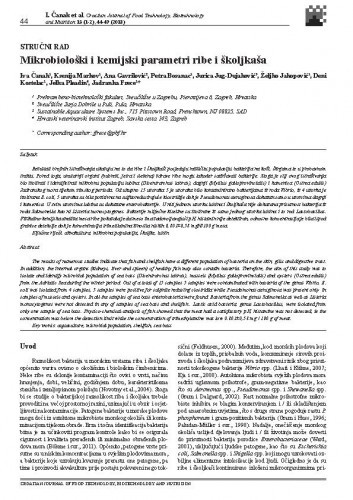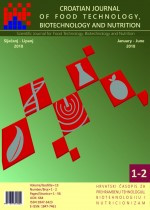Rezultati brojnih istraživanja ukazuju na to da ribe i školjkaši posjeduju različitu populaciju bakterija na koži, škrgama te u probavnom traktu. Pored toga, unutarnji organi (bubrezi, jetra i slezena) zdrave ribe mogu također sadržavati bakterije. Stoga je cilj ovog istraživanja bio izolirati i identificirati mikrobnu populaciju lubina (Dicentrarchus labrax), dagnji (Mytilus galloprovincialis) i kamenica (Ostrea edulis) Jadranskog mora tijekom zimskog perioda. Od ukupno 15 uzoraka 5 je uzoraka bilo kontaminirano bakterijama iz roda Vibrio, iz 4 uzorka je izolirana E. coli, 5 uzoraka su bila pozitivna na sulfitoreducirajuće klostridije dok je Pseudomonas aeruginosa dokazan samo u uzorcima dagnji i kamenica. U svim uzorcima lubina su dokazane enterobakterije. U niti jednom uzorku lubina i školjkaša nije dokazana prisutnost bakterija iz roda Salmonella kao ni Listeria monocytogenes. Bakterije mliječne kiseline su izolirane iz samo jednog uzorka lubina i to rod Lactobacillus. Fizikalno-kemijska analiza mesa ribe pokazala je da meso ima zadovoljavajući pH, histamin nije detektiran, odnosno koncentracija je bila ispod granice detekcije dok je koncentracija trimetilamina iznosila niskih 0,801±0,58 mgN/100 g mesa.; The results of numerous studies indicate that fish and shellfish have a different population of bacteria on the skin, gills and digestive tract. In addition, the internal organs (kidneys, liver and spleen) of healthy fish may also contain bacteria. Therefore, the aim of this study was to isolate and identify microbial population of sea bass (Dicentrarchus labrax), mussels (Mytilus galloprovincialis) and oysters (Ostrea edulis) from the Adriatic Sea during the winter period. Out of a total of 15 samples 5 samples were contaminated with bacteria of the genus Vibrio, E. coli was isolated from 4 samples, 5 samples were positive for sulphite reducing clostridia while Pseudomonas aeruginosa was present only in samples of mussels and oysters. In all the samples of sea bass enterobacteria were found. Bacteria from the genus Salmonella as well as Listeria monocytogenes were not detected in any of samples of sea bass and shellfish.. Lactic acid bacteria, genus Lactobacillus, were isolated from only one sample of sea bass. Physico-chemical analysis of fish showed that the meat had a satisfactory pH, histamine was not detected, ie the concentration was below the detection limit while the concentration of trimethylamine was low 0.801±0,58 mg / 100 g of meat.
Sažetak
Dio od

 Hrvatski časopis za prehrambenu tehnologiju, biotehnologiju i nutricionizam : Croatian journal of food technology, biotechnology and nutrition : znanstveno- stručni časopis za prehrambenu tehnologiju, biotehnologiju i nutricionizam : 13,1-2(2018) / glavni urednik, editor-in-chief Jadranka Frece.
Hrvatski časopis za prehrambenu tehnologiju, biotehnologiju i nutricionizam : Croatian journal of food technology, biotechnology and nutrition : znanstveno- stručni časopis za prehrambenu tehnologiju, biotehnologiju i nutricionizam : 13,1-2(2018) / glavni urednik, editor-in-chief Jadranka Frece.